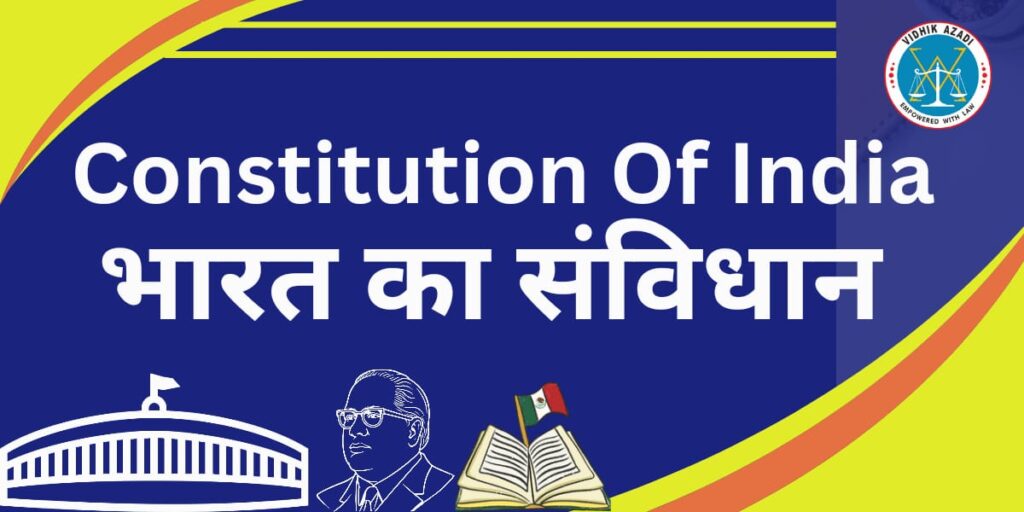Constitution of India

Constitution of India
India is governed in terms of the Constitution of India which is the Supreme law of India and was adopted by the Constituent Assembly on 26 November, 1949 and came into force on 26 January, 1950. The Constitution of India comprises several features such as Sovereignty, Socialism, Secularism, Democracy, Republic, Justice, Liberty, Equality, Fraternity and so on. All of them somehow work for Unity and Diversity.
The Constitution provides us a Parliamentary form of Government with Federal structure having Unitary features. It is the source of legal authority and empowers the Parliamentary and the Legislature of States and Union Territories. It binds the legislative, executive, and judicial organs of government. The Constitution of India empowers the independent judiciary to invalidate legislations or government actions which violate the constitution. The decisions of the Supreme Court are followed by all courts within the country. The rule of law in the constitution of India is a fundamental principle that emphasizes the importance of equality before the law, prohibition of conduct, protection of individual rights and serves as a safeguard against abuse of power, ensuring that no one violates the law with position or regardless of position.
The Constitution of India provides several jurisdiction such as Original Jurisdiction, Writ Jurisdiction, Appellate Jurisdiction, Advisory Jurisdiction, A court of Record, Power of Judicial Review and so on. The Power of Judicial Review given by the Constitution itself maintains federal equilibrium and supremacy of the Constitution. The Constitution of India is unique and is called the Paradise of the Lawyers because the legal language and phraseology adopted by the Constitution makes it a complex document.
The Constitution of India empowers Parliament either Union or States and is a source of legal authority. Although India is a land of diversities, religions, and customs, our Constitution provides empowerment to every person ensuring them stability in life in any circumstances.
भारत का संविधान
संविधान से तात्पर्य ऐसे दस्तावेज से है जिसकी एक विशिष्ट विधिक पवित्रता होती है। जो राज्य सरकार के अंगों कार्यपालिका, विधायिका और न्यायपालिका के ढांचे को और उनके प्रमुख कार्यों को निर्दिष्ट करता है और इन अंगों के संचालन के लिए मार्गदर्शक सिद्धांतों को समाहित करता है।
सरकार की शक्तियों का विभाजन एक लिखित संविधान द्वारा होता है। अतः यह भी संभव है कि संविधान से संबंधित उपबंधो की व्याख्या अपने-अपने पक्ष में करें। इस शक्ति विभाजन को बनाए रखने के लिए, जिससे की विभिन्न सरकारें एक दूसरे के कार्य क्षेत्र में हस्तक्षेप न करें, संविधान के उपबंधों की सही व्याख्या आवश्यक है। इसके लिए एक ऐसी संस्था की आवश्यकता होती है जो स्वतंत्र एवं निष्पक्ष हो और केंद्रीय तथा राज्य सरकारों के बीच विवादों को निष्पक्षता से निपट सके। संघीय व्यवस्था में यह कार्य न्यायपालिका को सौंपा गया है। भारतीय संविधान के अंतर्गत यह कार्य उच्चतम न्यायालय को सौंपा गया है। संविधान के उपबंधों की व्याख्या के संबंध में अंतिम निर्णय लेने का अधिकार उच्चतम न्यायालय को ही जाता है। इसके द्वारा की गई संविधान की व्याख्या को सभी को मानना पड़ता है, इसलिए उच्चतम न्यायालय की को “संविधान का संरक्षक” कहा जाता है।
उच्चतम न्यायालय न केवल संविधान का वरन नागरिकों के मूल अधिकारों का भी संरक्षक है। यह सामाजिक हित तथा व्यक्तिगत हित के बीच सामंजस स्थापित करने का कार्य करता है। यह देश का सर्वोच्च न्यायालय है, जिसे देश की साधारण विधियों की व्याख्या के संबंध में अंतिम निर्णय देने का अधिकार प्राप्त है। यह सिविल और फौजदारी के मुकदमों का सर्वोच्च अपीलीय न्यायालय है।
